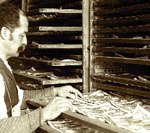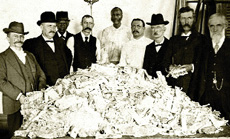Top Questions
Top Questions About Collecting Paper Money
We've compiled some of our most frequently asked questions and organized them by category. Choose your topic and read the answers below.
1. What makes paper money valuable?
Age does not always make paper money valuable, though it is usually a factor. In fact, some 1861-65 Confederate States of America notes from the Civil War era cost much less than some large-size U.S. notes from the early 1900s. Value, as for most items, is determined by the interrelated factors of scarcity, condition and demand. For example, if many more notes of an earlier series have been produced than a later one, there may be far more older notes that survive. It also depends on how many of each have been saved, and their condition. Condition is important in determining value. An Uncirculated piece may be worth many times more than an average circulated note of the same series and denomination.

Drying large-size bills at the U.S. Treasury
Demand is also a major factor. Some types of paper money, such as large-size Silver Certificates and Legal Tender Notes, are more popular than others. So, with more collectors seeking the same notes, prices will be affected.
2. Why is collecting paper money so popular?
Paper money is an exciting collector hobby because notes are colorful, informative, and attractive. You can learn about art, economics, and even technology by studying paper money and the stories behind it. Plus, it's also a genuine artifact of the past, capturing exciting areas in American and world history. As far as the hobby itself, the serious, organized collecting of paper money dates back to the early to mid-20th century. Today, it's one of the fastest growing areas of numismatics.
3. When was the first paper money issued?
Paper was invented by the Chinese around A.D. 105, so it's not surprising that they produced the first paper money! Although no examples exist today, a manuscript tells of a paper note issued in China around A.D. 650.
The oldest existing collectible paper note dates from 1368, and is from the Ming Dynasty. This note is huge, measuring approximately 9″ x 13″. Its paper was made from the inner bark of the mulberry tree. The first true European bank note was issued in 1661 by a private bank in Sweden, while the first paper money in the New World was issued in 1690 in Massachusetts Bay Colony (one of the earliest New England settlements in present-day Massachusetts).
4. How many different types of U.S. Paper Money are there?
From the first Colonial Note printed in 1690 by the Massachusetts Bay Colony to the latest series of revised federal currency (starting with the Series 2006 Abraham Lincoln $5 Federal Reserve Note), many types of paper money have been issued in the course of our nation's history.
Non-federal issues include various Colonial Notes from individual colonies, Continental Currency, emergency-issue government Treasury Notes, a wide variety of state-chartered bank notes, and notes of the Confederacy and Southern States.
Federal issues include Demand Notes, Fractional Currency, large and small-size Legal Tender Notes (also known as United States Notes), short-lived Compound Interest Treasury Notes, Interest Bearing Notes (rarest of all U.S. paper money), Refunding Certificates, large and small-size Silver Certificates, Treasury (Coin) Notes, large and small-size National Bank Notes, Federal Reserve Bank Notes, Federal Reserve Notes, and Gold Certificates.
5. Are there different ways to collect?
Yes, absolutely! In fact, it can be said that there are as many different ways to collect paper money as there are collectors. You see, there is really no one "right" way. It depends on your interests and what gives you the most enjoyment within your collecting budget.
That said, there are a few "traditional" ways to go about it. At first, you may pursue a general collection containing a variety of different notes. As you find examples of different large and small-size notes – Legal Tenders, Silver Certificates or Nationals, for instance – you notice you're attracted to some more than others.
Then, you may want to assemble a complete set – every signature combination of a particular series, for example. Or you may prefer to collect one of each different $1 note, then go after $2 or $5 notes. You might want one example of each Silver Certificate (or other note type) issued. Some collectors choose to assemble a set of notes that all portray a related theme – like presidential portraits, military leaders, modes of transportation, or allegorical figures. Whichever way you choose to collect, the most important thing is to have fun.
6. How do I start a paper money collection?
Once you become interested in paper money, it's natural to want to collect everything. But as a beginning collector, it's important to decide what kind of notes interest you the most and start with those.
To become familiar with paper money, it would be a good idea to review the information available on our How to Collect Paper Money page. It's a great way to explore the wide range of paper money types and designs, and it might help you decide where to start.

1.6 million dollars worth of destroyed paper currency at the U.S. Treasury
When you decide, keep in mind that you can purchase paper money easily and conveniently by mail no matter where you live. Littleton offers catalogs, price lists, and paper money "on approval" – so a large inventory is always available for you to choose from. You should only purchase paper money from a company that guarantees your satisfaction (like Littleton). For more ways Littleton can help you start and expand your collection, see What Can Littleton Do For Me?.

